Hudson '09
'09 maps for:
Bea
--
Buck -- Caley --
Claws --
Conomo --
Hix --
Hudson 09 -- Isabel --
Katy -- L.R. --
Moffet --
Mr. Hannah --
Ozzie --
Penelope
--
Rafael
2010 maps for: Belle
-- Buck --
Gunny --
Hudson --
Mr. Hannah --
Neale --
North Fork Bob
--
Penelope --
Sanford
-- Sr. Bones --
Thatch
2011 maps:
Belle --
Buck --
Henrietta --
Katbird
-- North Fork Bob --
Pemi --
Saco --
Sanford --
Sr. Bones --
Snowy --
Thatch -- Tucker
2012 maps: Art --
Belle --
Bridger --
Chip --
Cutch --
Jill -- North Fork Bob --
Rammie --
Snowy --
Sr. Bones -- Thatch
2013 maps: Art --
Belle --
Bridger --
North Fork Bob --
Rammie --
Snowy --
Sr. Bones
Osprey
main page --
Migration
page --
Migration09 --
Migration10 --
Migration 11 --
Migration 12 --
Migration 13 -- Home
Page
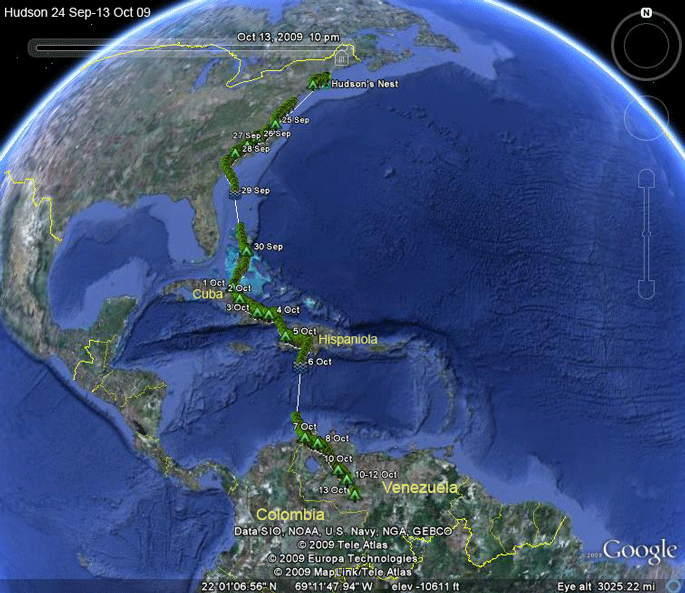 |
Travels so far: 24 Sep-31 Dec 09. Hudson made it to Venezuela in
exactly two weeks. No moss growing on this bird! Not a record, but a
pretty fast trip. Once in Venezuela, he has continued moving south, with only one multiple-day stopover. He spent some time in a very strange area of the Venezuelan llanos before settling down, apparently, along the Rio Meta on the Colombian-Venezuelan border. Scroll down for detailed maps. The migration maps are here, just captionless at the moment. Jump to start of migration. Jump to central Venezuela. Latest update (starting 1 Dec.) Go to 2010 migration north |
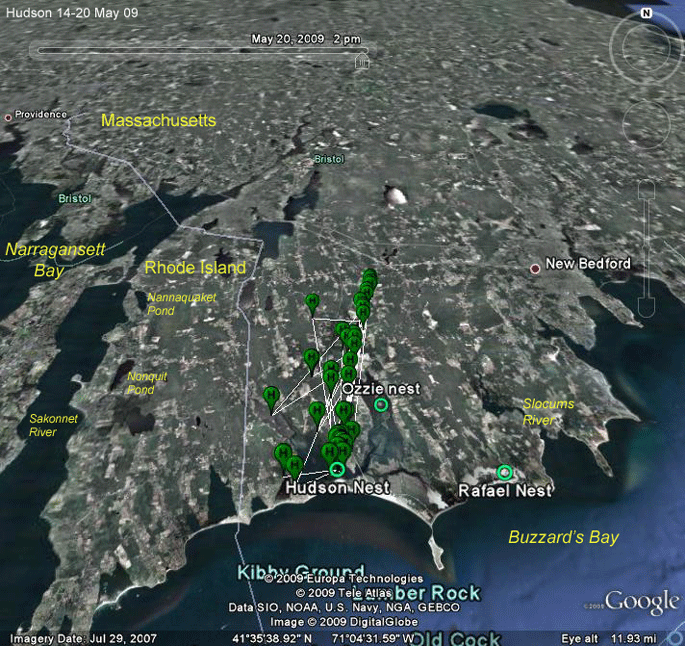 |
Mid May
09.
Hudson seems to be finding all the
fish he needs up and down the Westport River. All three of our Westport
River birds (Rafael, nesting over on Allen's Pond, is an honorary member
of the club) have spent time on the upper Westport, where the word must
be out about especially good fishing. I've labeled Nannaquaket and Nonquit Ponds for a reason that will be apparent in the next map. Below are maps in chronological order beginning with May '09. |
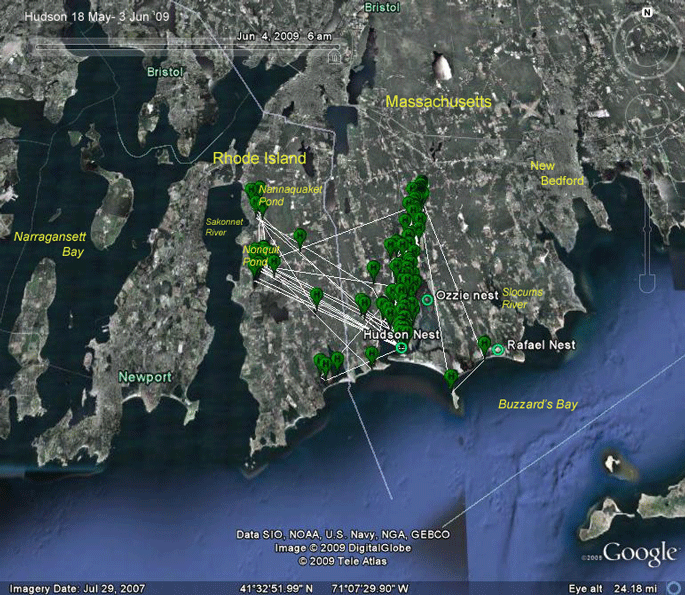 |
18 May- 3 June
09.
Hudson is expanding his hunting area.
He's been over to Nannaquaket and Nonquit Ponds just east of the
Saconnet River and down to Tunipur and Quicksand Ponds. Nannaquaket Pond
is about 9 miles (14.3 km) from his nest. He has also been down on the shore near Rafael's nest. |
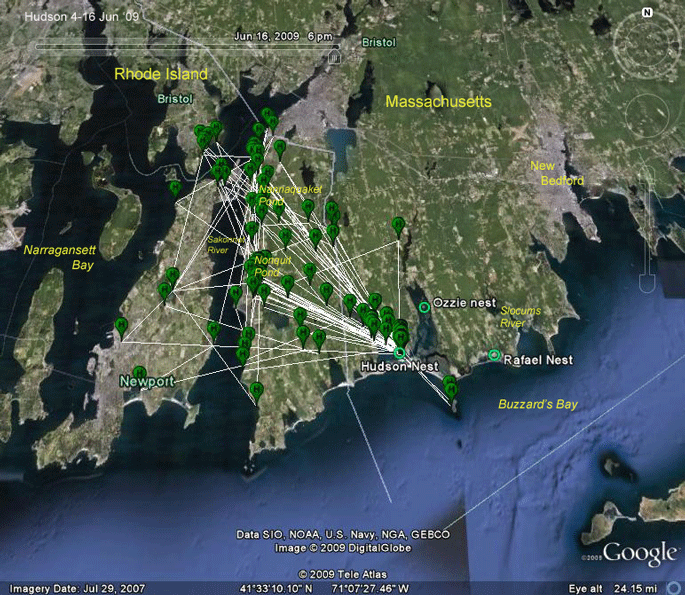 |
4-16 Jun
09.
This is a really dramatic change.
Hudson has abandoned the east branch of the Westport almost completely
and is working west. The insider info is that the menhaden have arrived,
"right on schedule," and at least some (see Rafael's maps for the
counter-example) of the local Ospreys are taking advantage of the new
resource. Predator-prey relations are fluid. Ospreys depend on different fish species over their five-month breeding season, feeding on whatever is temporarily abundant. |
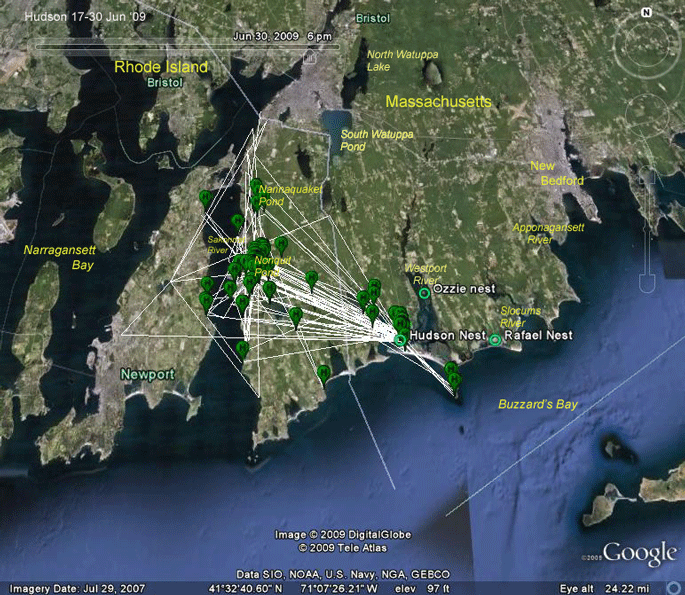 |
17-30 Jun 09. Hudson is focusing his hunting on Nannaquaket and Nonquit ponds. |
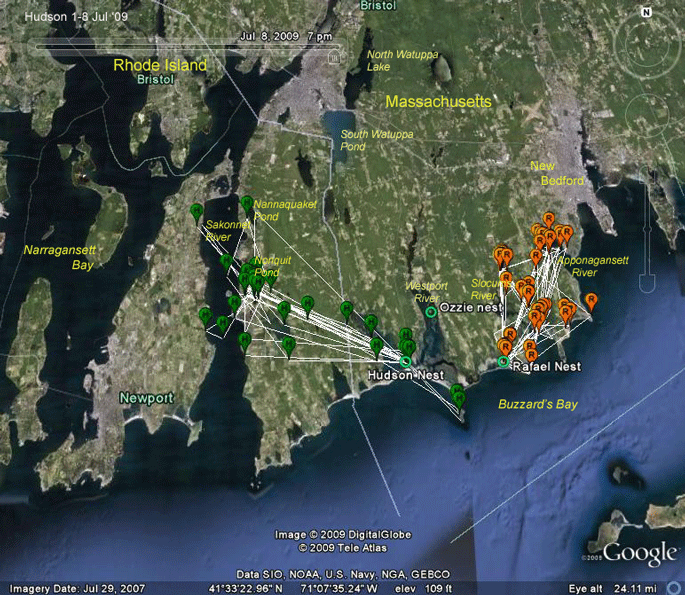 |
1-8 Jul 09. More of the same for Hudson. I've included the activity for Rafael on this map as well for the contrast. These were the last locations we received from Rafael's transmitter, which very abruptly, and hence mysteriously, stopped transmitting on 7 July. |
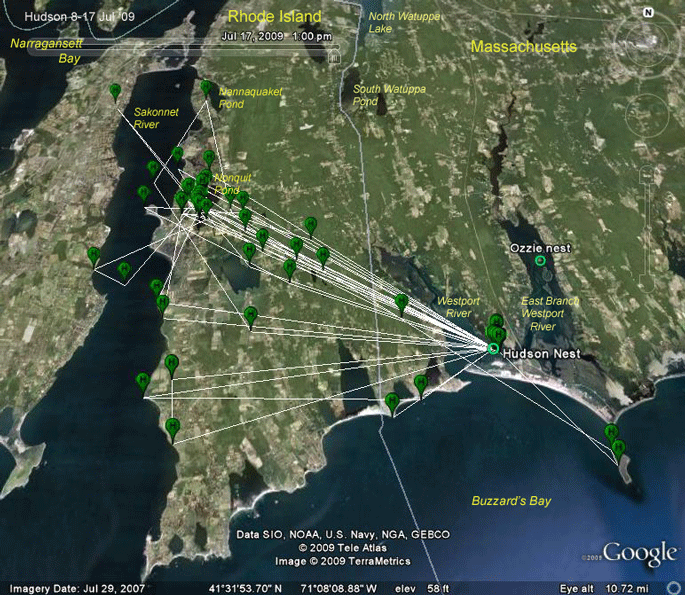 |
8-17 Jul 09. Hudson is now doing most of his fishing at Nonquit Pond. |
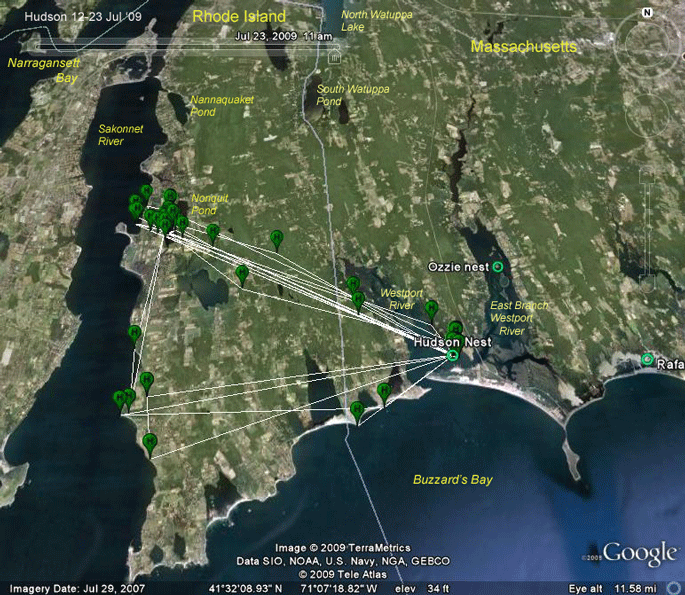 |
12-23 Jul
09.
Now he's really concentrating on
Nonquit Pond. In stark contrast, Ozzie is, quite literally, all over the
map. In the next map I've included all three birds. |
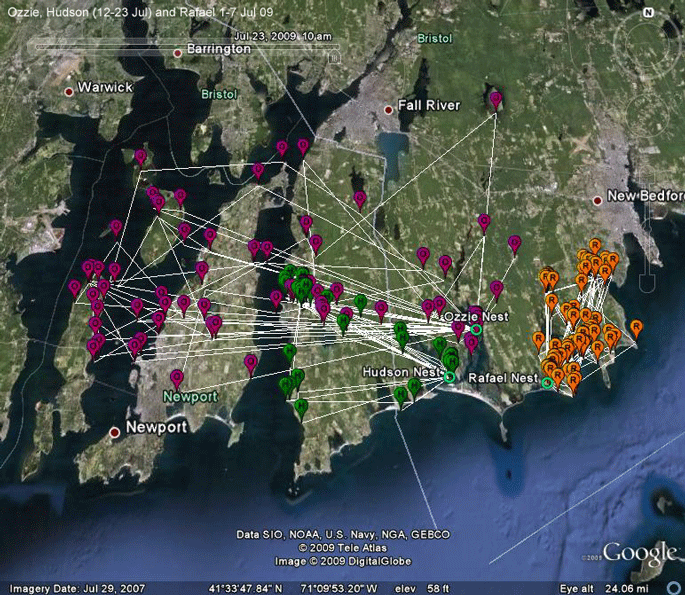 |
1-23 Jul
09. (If you looked at Ozzie's maps first, you've already read this:) Data from all three birds are included in this map. Rafael's data are only for the first week of July--his transmitter stopped transmitting on the 7th--while the data for Ozzie and Hudson are from the middle two weeks of the month. The contrast between the three birds we tagged is a really neat bit of science, making the case for large sample sizes. While three isn't really a large sample, and no case really needs to be made for large samples, the three birds we tagged make it clear that tagging only one bird would have given us a very incomplete picture of Osprey foraging in this colony. There is a tendency to forget that animals are individuals. We read that the average territory size for species X is 10 hectares and think that all birds of that species use 10 ha territories, when in fact, of course, there are some birds that have 15 ha and some have 5 ha territories. Animals are individuals with unique combinations of genes, as Ozzie, Hudson, and Rafael so dramatically illustrate. Natural selection operates on individuals, not on a hypothetical average organism. It's exactly this sort of variation that enables natural selection to work. |
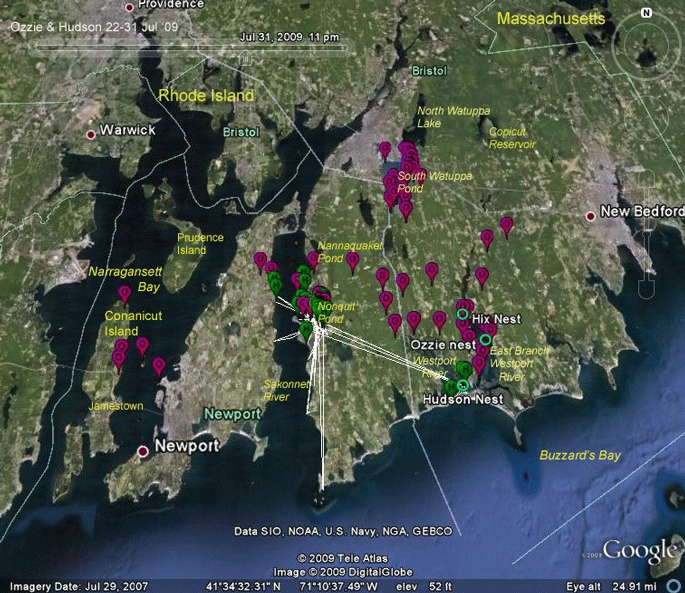 |
22-31 Jul 09. Here's an interesting comparison between a bird whose nest has failed (Hudson) and one still feeding young (Ozzie). Hudson was back at his nest only for a couple of visits at the very end of July. |
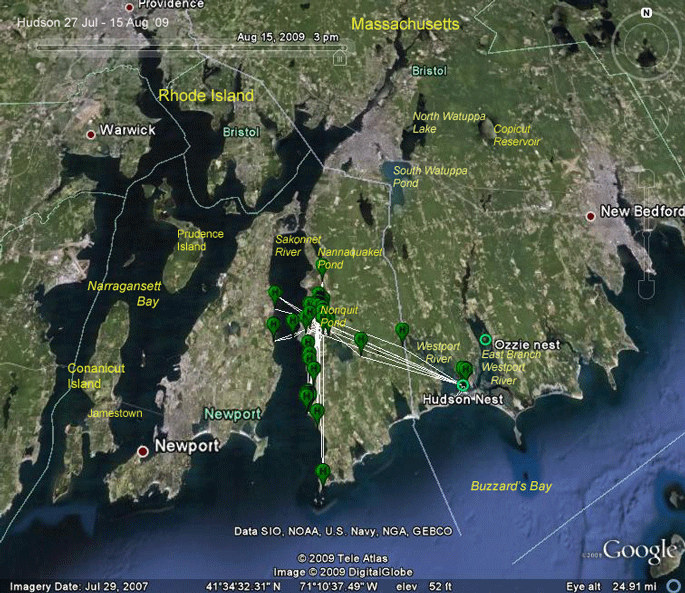 |
27 Jul - 15 Aug 09. Hudson is doing most of his fishing at Nonquit Pond, although he's been down the east side of the Sakonnet River a bit. He was back at his nest for a couple of visits at the end of July/beginning of August and then again only on the 15th. He should be heading south in a few weeks. Males typically go in September. It will be interesting to see if he goes early, given the lack of parental responsibilities. Experience with previously tagged males whose nests had failed suggest that they don't leave any earlier than successful males. |
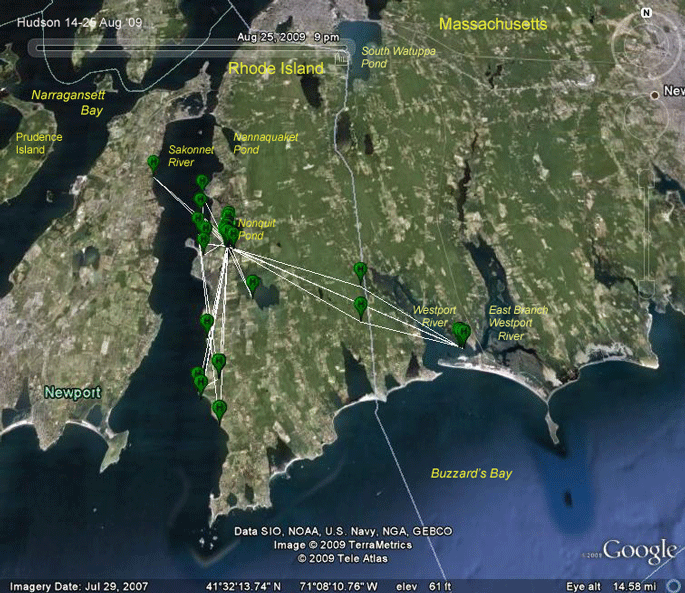 |
15-24 Aug 09. In the immortal words of Yogi Berra, it's deja vu all over again. A couple of visits back to the nest, but still mostly just fishing Nonquit Pond. |
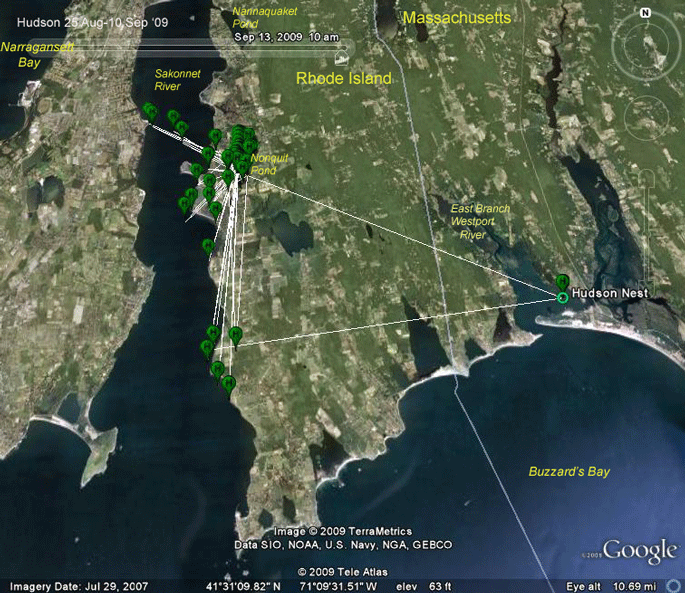 |
25 Aug-10 Sep 09.
Hudson is still in a rut. He's fishing
almost entirely at Nonquit Pond. Obviously, the fishing is good there. He's been back to his nest only once (Aug 27) during this three-week period. |
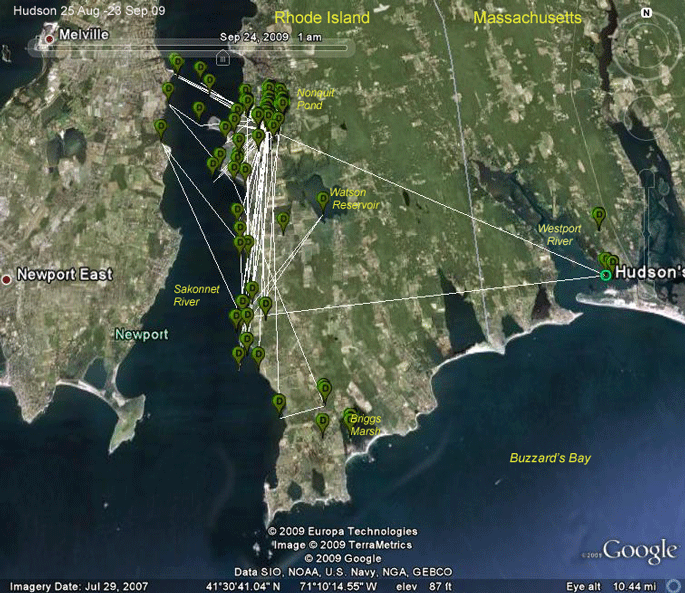 |
24 Aug-24 Sep 09. These are the locations for Hudson in the month before he headed south (some overlap with the previous map). He continued to focus a lot of attention on Nonquit Pond. At the same time, Hudson began fishing a lot more along the shore of the Sakonnet River, suggesting the arrival of some new fish on the scene-probably menhaden. He's waiting for the combination of migration urge (stimulated by shortening daylength), nutritional levels, and the right weather (a nice cold front with strong NE winds) to get him moving. Well, I guess technically, it's not Hudson that's waiting, we're the ones doing the waiting. He's just being an Osprey. |
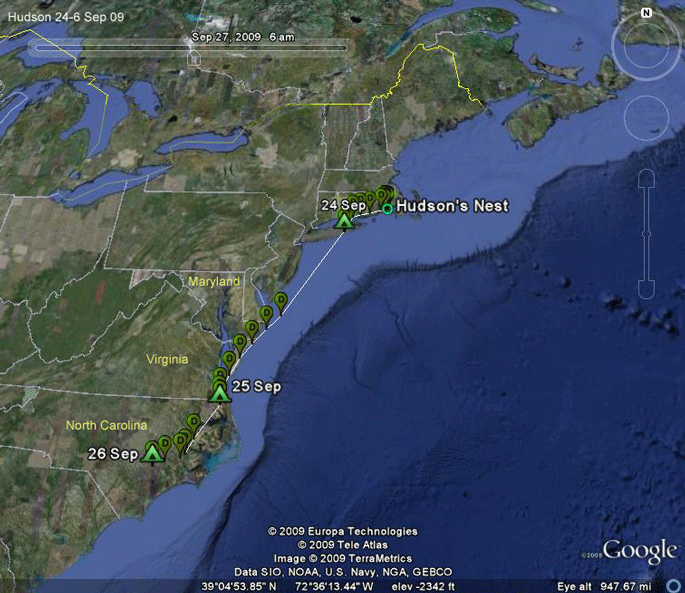 |
24-26 Sep 09. Hudson started his migration on the 24th. His first leg of the trip was a short one, just over to Long Island. The first of several unusual things that Hudson has done on his trip south was to start migrating at about 04:00 and to head out over the ocean, skipping New Jersey altogether. This is a first. He made it to North Carolina on the 25, roosting north of Albemarle Sound. On the 26th he moved 144 miles (232 km) southwest. |
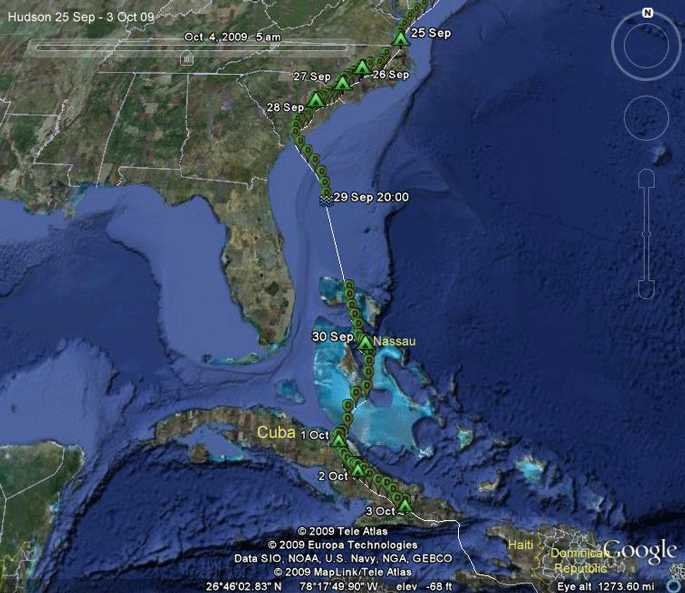 |
26 Sep-3 Oct 09. Hudson kept pushing south, moving into South Carolina on the 28th. On the 29th he made another very unusual move. All but one of the birds we have followed the were travelling down the SC coast continued over land to Florida. Hudson left the SC coast just north of Hilton Head Island and flew through the night (the blue squiggly symbol on the map indicate our last GPS fix for the day) to the Bahamas. He spent the night on New Providence Island (where Nassau is found). He got a late start (by his standards) on 1 Oct, pushing off around 10:00. He made it to Cuba about 7 hours later, and kept moving south for the next two days. 1835 miles (2953 km) under his belt so far as of 3 Oct. |
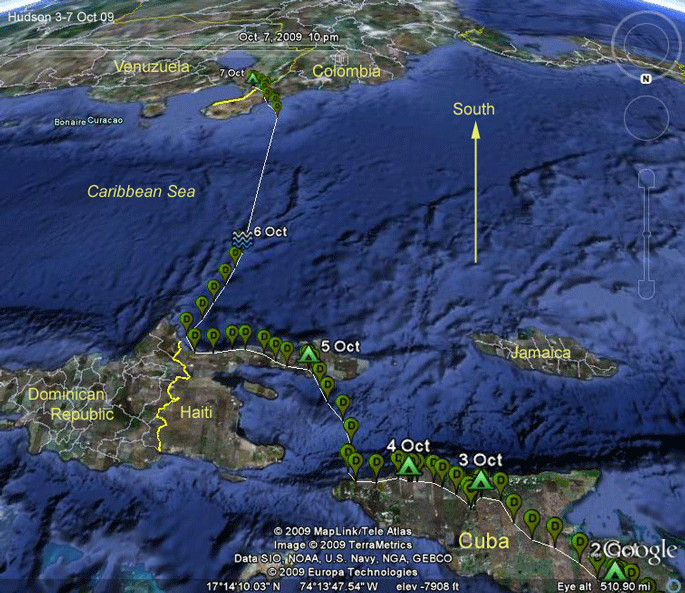 |
3-7 Oct 09. We're looking south here, over Hudson's shoulder as he heads to South America. He roosted one more night in Cuba at Guantanamo Bay. On the 5th he headed over to Haiti and then made his move over the Caribbean on the 6th, leaving land around 16:45. He arrived in Colombia 19.5 hours later, having crossed 450 miles (724 km) of open water. He was apparently feeling pretty frisky after that flight and just kept on moving inland. He may have stopped to rest, but it was for no more than a few minutes, as his track continues for three hours after he got to Colombia with each hourly fix at least 18 miles ahead of the last. He finally got to Venezuela and settled down west of the Gulf of Venezuela. |
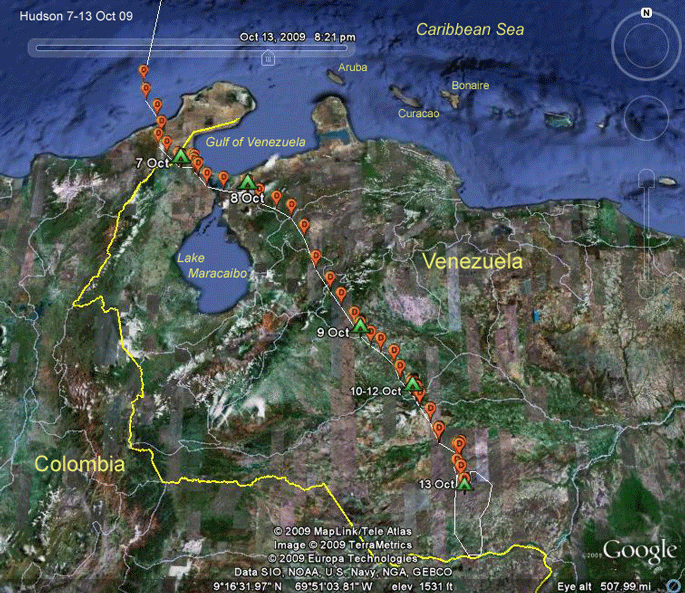 |
24 Sep 09. Hudson moved southeast into Venezuela another 173 miles (278 km) on the 9th. He spent a couple of days along the Apure River before another move south into the llanos of the state of Apure on the 13th. |
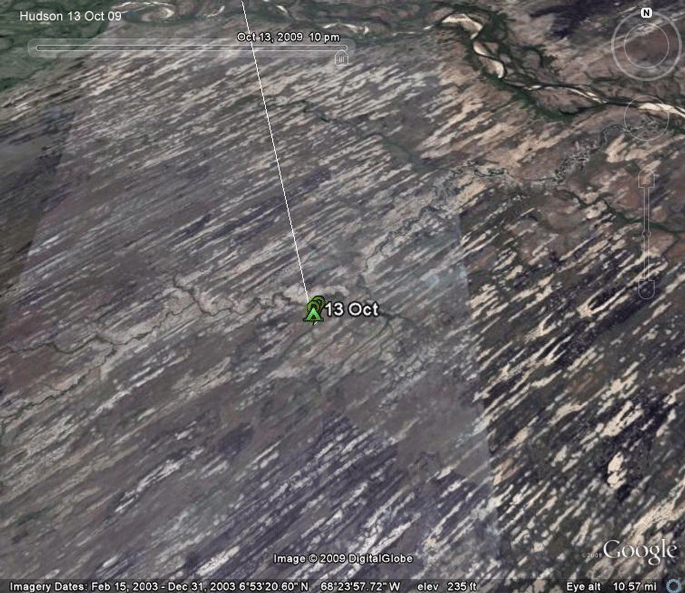 |
13 Oct 09. This is a strange landscape indeed. The white striations are large sand dunes that have apparently been deposited by the trade winds picking up sand along rivers banks when the rivers are low, exposing large sand banks (see below). One does learn about all sorts of things following Ospreys on migration! |
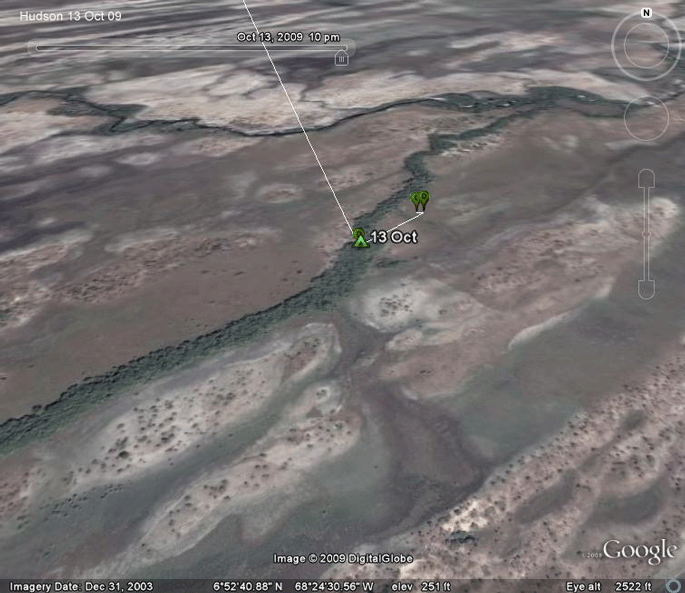 |
13 Oct 09. A closer view of the sand dunes (medanos) that stripe the wet llanos in Apure. This does look like the end of Hudson's migration. In 17 days, he flew 3,120 miles (5,021 km), averaging 184 miles (295 km)/day. Now that I've predicted the end of his migration, he'll probably fly another 500 miles south! |
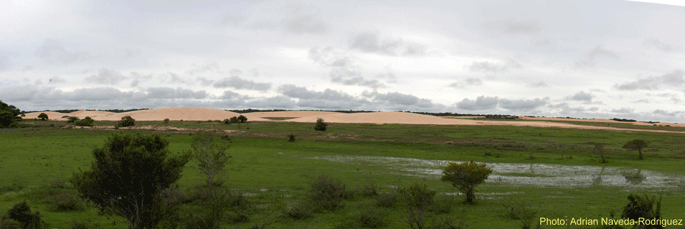 |
A land-based view of the habitat Hudson seems to have settled into. |
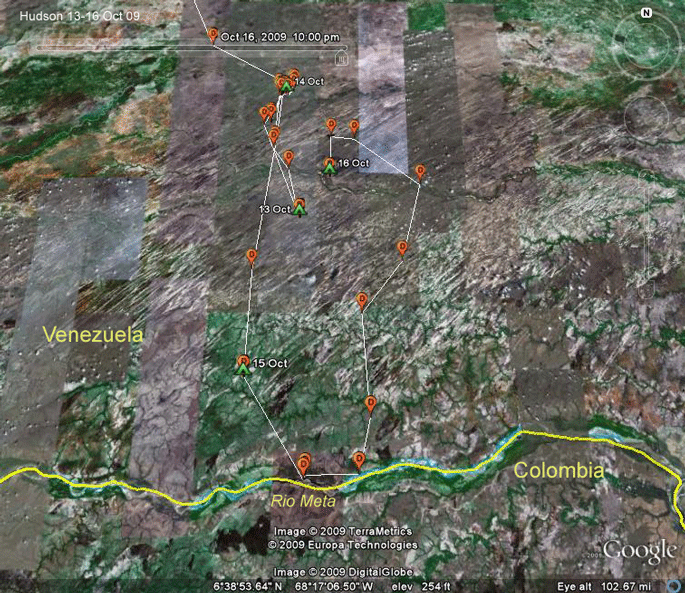 |
13-16 Oct 09. Hudson made a loop down to the Rio Meta, which forms the border between Colombia and Venezuela, and back up into the middle of the state of Apure. |
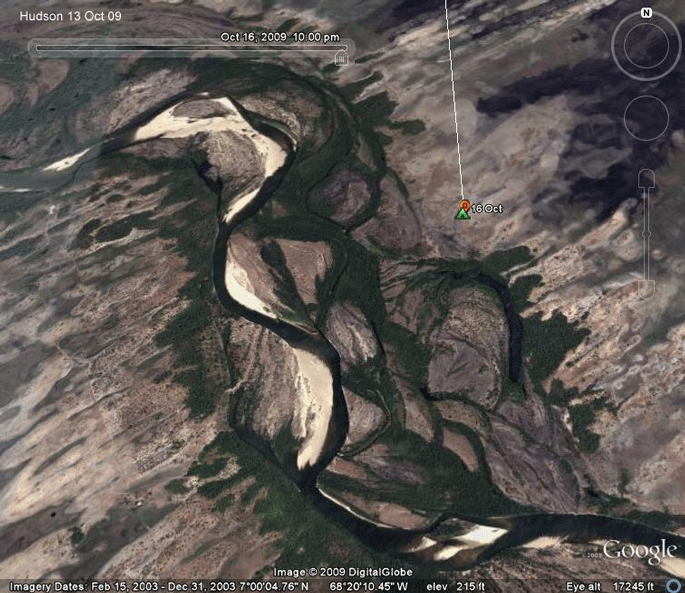 |
16 Oct 09. The history of this river's meandering is clearly written in the landscape here. The sandbanks are purportedly the source of the sand deposited in the long dunes away from the rivers. |
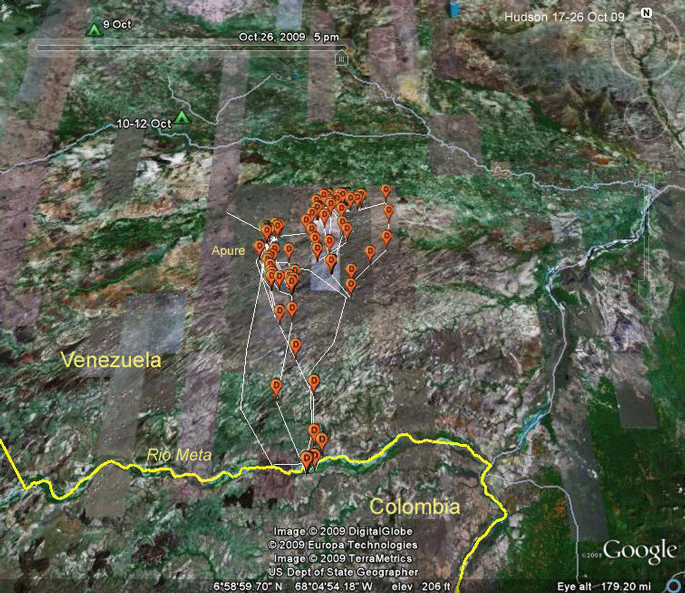 |
17-26 Oct 09. Hudson continues to wander around this strange, dune-filled countryside in the Venzuelan state of Apure. He made another trip down to the Meta River, which forms the southern boundary with Colombia. This is more movement than we have come to expect from an adult when they arrive in their wintering area. Typically, they go to one spot and just settle right down. Mr. Hannah's migration this year exemplifies that pattern. |
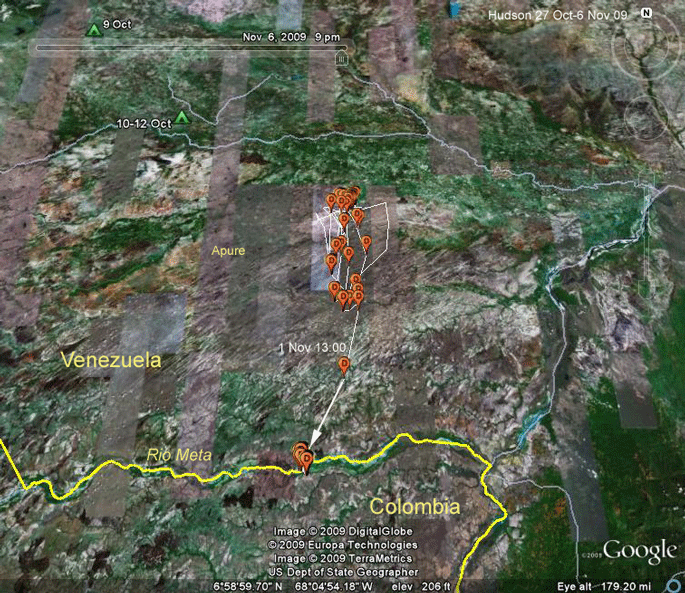 |
27 Oct-6 Nov 09. After another 4 days up in northern Apure, Hudson moved down to the Meta River on Nov 1 and seemed to settle down. |
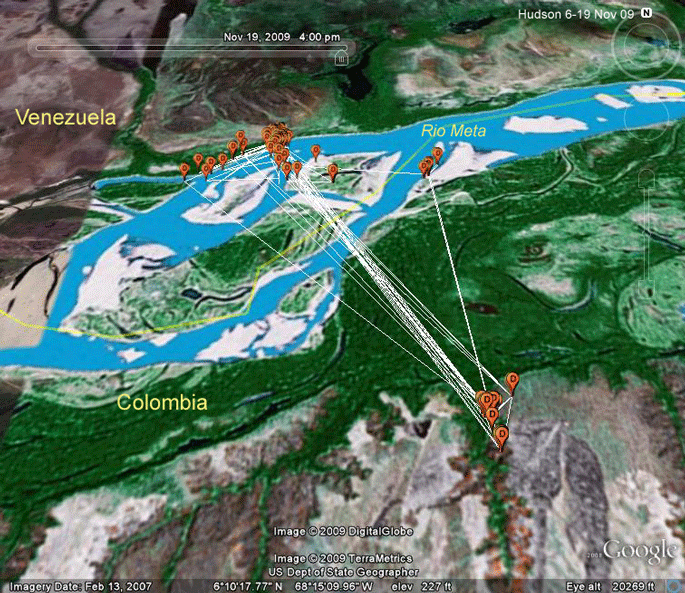 |
6-19 Nov 09. This is what we expect to see in adults when they get back to their winter quarters. |
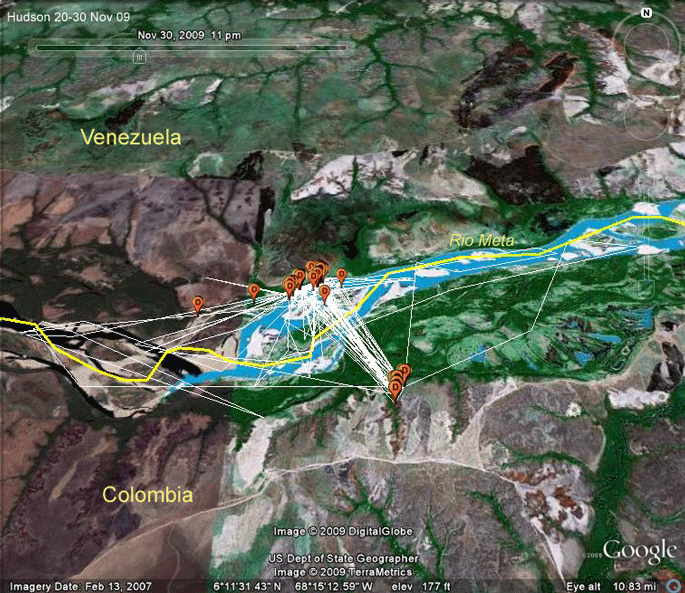 |
20-30 Nov 09. The locations for Hudson in the last 10 days of November. From here on until his return in February or March, I'll just post monthly updates (unless he does something very unexpected). |
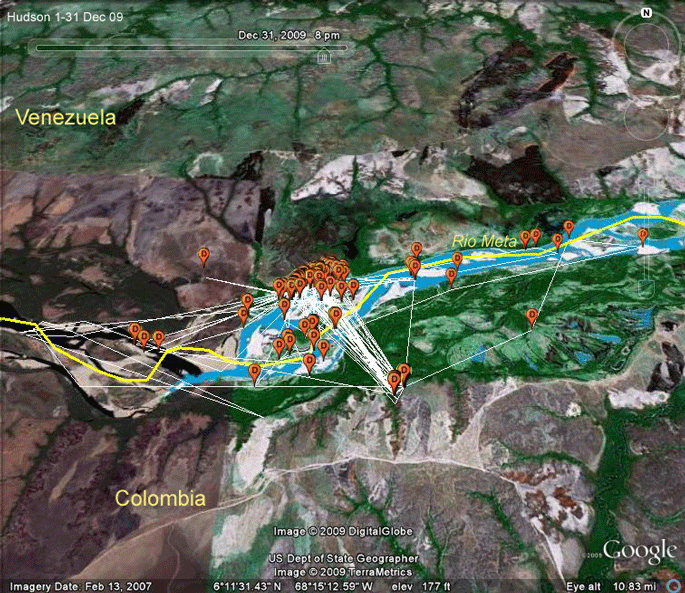 |
1-31 Dec 09. Most of his activity is restricted to a very small area along the Meta River. The farthest he has strayed is 7 miles (12 km) downstream. |
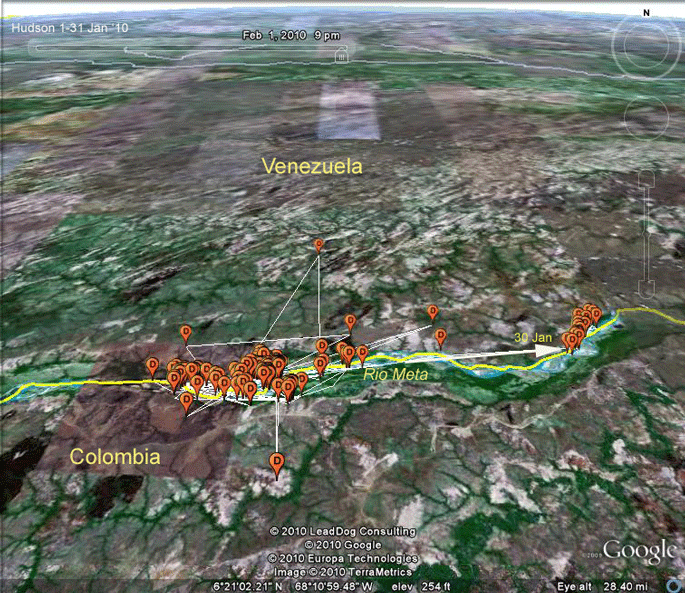 |
1-31 Jan 10. This is an interesting shift downriver for an established adult. He should head north in February. |
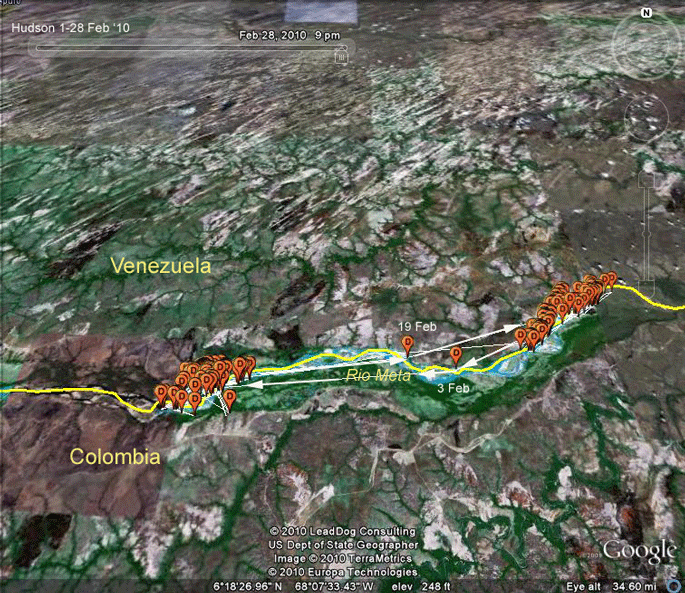 |
1-28 Feb '10. He started the month at his eastern fishing area, flew upriver on the 3rd, spent a couple of weeks at his original area, and then flew back downriver on the 19th. OK, he should start his trip north in March. |
Birds of Prey page -- Osprey main page -- Migration page -- Home Page